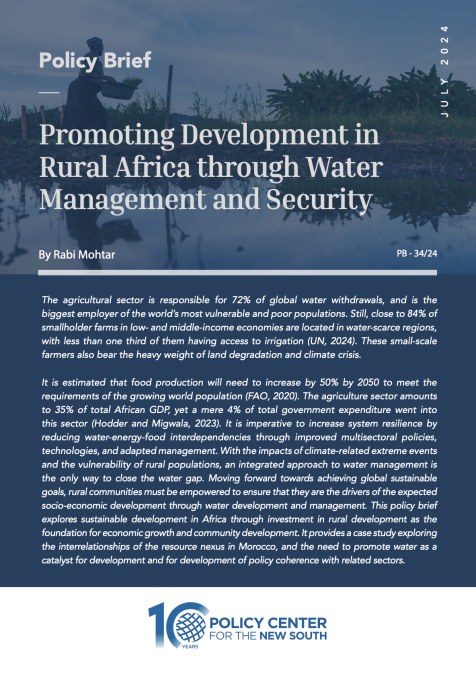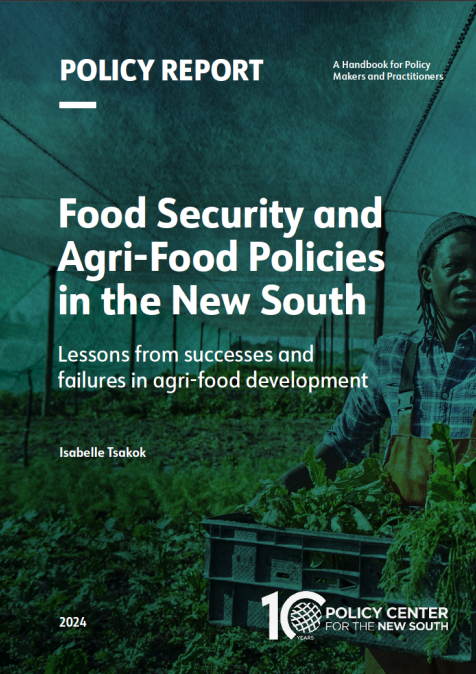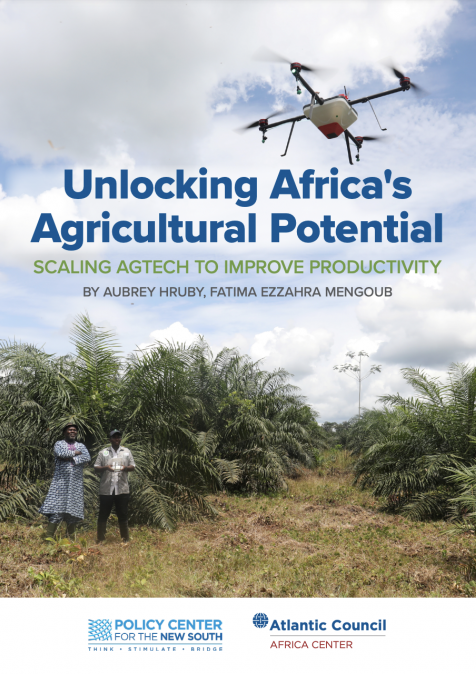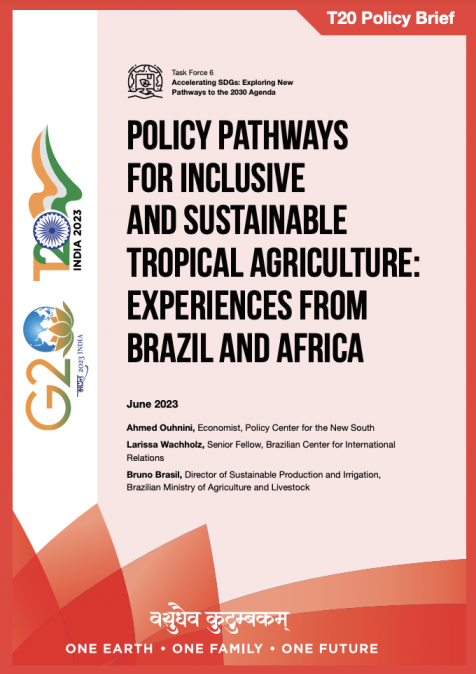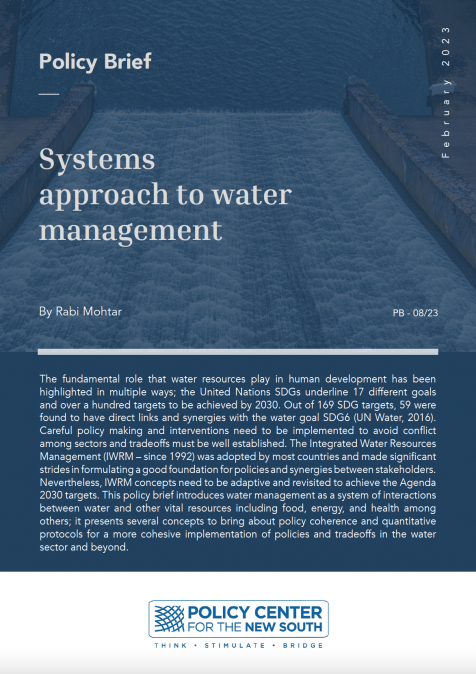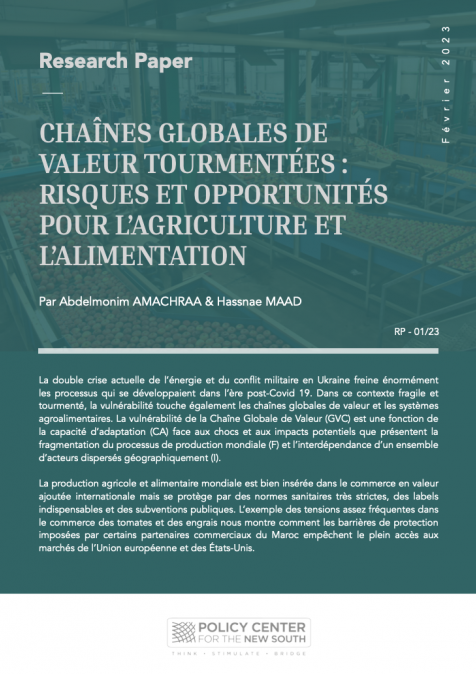Publications /
Policy Brief
The agricultural sector is responsible for 72% of global water withdrawals, and is the biggest employer of the world’s most vulnerable and poor populations. Still, close to 84% of smallholder farms in low- and middle-income economies are located in water-scarce regions, with less than one third of them having access to irrigation (UN, 2024). These small-scale farmers also bear the heavy weight of land degradation and climate crisis.
It is estimated that food production will need to increase by 50% by 2050 to meet the requirements of the growing world population (FAO, 2020). The agriculture sector amounts to 35% of total African GDP, yet a mere 4% of total government expenditure went into this sector (Hodder and Migwala, 2023). It is imperative to increase system resilience by reducing water-energy-food interdependencies through improved multisectoral policies, technologies, and adapted management. With the impacts of climate-related extreme events and the vulnerability of rural populations, an integrated approach to water management is the only way to close the water gap. Moving forward towards achieving global sustainable goals, rural communities must be empowered to ensure that they are the drivers of the expected socio-economic development through water development and management. This policy brief explores sustainable development in Africa through investment in rural development as the foundation for economic growth and community development. It provides a case study exploring the interrelationships of the resource nexus in Morocco, and the need to promote water as a catalyst for development and for development of policy coherence with related sectors.
BACKGROUND
The Water Gap and Climate Change in Africa
Africa’s renewable water resources comprise less than 9% of the estimated total global renewable resources. About 85% of Africa’s water withdrawals are for agriculture, and even though 25% of the world’s arable land is in the sub-Saharan Africa, the whole of Africa produces only 10% of global agricultural output (FAO, 2016).
Averaged across Africa, annual precipitation is about 678 mm, ranging from 51 mm (hyperarid) to 3200 mm/yr (tropical). While With less than 1% of Africa’s total renewable water resources, North Africa is the driest region; with 48%, Central Africa is the wettest region (FAO, 2016).
Africa has nearly one third of the world’s international water bodies, with around 80 international rivers and basins. Despite this, cooperation is lacking and almost no shared governance plans exist, making rural communities more vulnerable to conflict and lack of access to water for agriculture (UN Water, 2003) The major18 international water basins in Africa include the Congo/Zaire, the Nile, and the West basins.. While the irrigation potential in Africa totals 42.5 million ha, the actual irrigated acreage is Africa is only 13.4 million ha, and this water is unequally distributed. Lowland cultivation constitutes 13% of the total water-managed areas of Africa (FAO, 2016).
More than one third of African countries, with more than half a billion people, are considered water insecure (MacAlister et al, 2023; Oluwasanya et al, 2022).
Sub-Saharan Africa is expected to be strongly affected by climate change due to its heavy reliance on agriculture. One model of water resources in a region of West Africa projected decreases of 1% to 4% in the discharge from the Sassandra River for the period 2021-2040 (Coulibaly et al, 2018). Climate change affects crops directly through crop loss, and indirectly through decreased water availability and increased pests and diseases (UN, 2024).
Most climate models and predictions indicate that drought and flood events will increase in frequency and severity, causing in many cases irreversible damage to water ecosystems (IPCC, 2023). Drought, flow changes, and flooding events all affect water quality by increasing salinity, pollutants, and water nutrient levels, as well as by reducing the amount of arable land (Kusangaya et al, 2014). Resilience is highly dependent on addressing these threats through adapting water-resource management.
The 2030 Water Resource Group projects a 17% water gap for South Africa, and that 784 million people in sub-Saharan Africa will also be affected. The gap exists as a consequence of natural water allocation, inefficient use of available water, and lack of synergy in water use (Danert et al, 2016).
Different Challenges Across the Continent
Water security varies by region: in South Africa, the challenge is distribution and storage; in the north, it is scarcity. Across the continent, water affects health, food security, poverty reduction, and livelihoods.
The main challenges for Africa’s smallholder farmers are limited access to water, growing dependence on groundwater, increasing aquifer depletion, and extensive use of diesel as a source of energy. These are in addition to the competition for water between the energy and agriculture sectors.
Taking into account these challenges and other regional aspects, choosing the most appropriate production systems and technology for the water and energy sectors must account for: a) resource requirements in terms of water, energy, and land, b) economic and financial aspects, c) environmental impacts on land, water, and air, d) human resources needed to develop and maintain the technologies, e) technical suitability to local conditions and robustness, and f) social and cultural suitability to local practices. Also, innovative practices must include the integration of soft technologies such as models and computer tools, to help reduce interdependencies of water, energy, and food.
Technological solutions to make farming more efficient remain a priority. Precision agriculture has proven successful, and, more recently, artificial intelligence applied in agriculture promises a paradigm shift in farming. AI-powered solutions will only enable farmers to do more with less, and will also improve quality and ensure shorter seed-to-market time for crops.
Most crops produced around the world are rainfed. Only around 40% of global agriculture production comes from irrigated land, which is only about 20% of all agricultural land (OECD/FAO, 2021). Important for food production and natural vegetation, and underpinning biodiversity, green water (water held in the soil matrix) accounts for 87% of the water used in global crop production.
Scientists and policymakers need to recognize the importance of green water, especially in dryland countries (Mohtar and Assi, 2018). Managing the different types of water in water-scarce regions requires scientific approaches that account for green water and soil parameters, and transmit this knowledge to decision-makers (Mohtar and Assi, 2018; Braudeau et al, 2016; Blake et al, 2019).
According to the World Bank (Our World in Data, 2024), the agricultural value added per farm worker in sub-Saharan Africa was around $1,500 in 2019, while added value for a U.S. farm worker exceeded $100,000. These shocking numbers clearly point to the need to invest and improve African farm productivity.
RURAL TRANSFORMATION AND SOCIO-ECONOMIC ISSUES
Beyond the technological challenges and solutions, social issues affect rural transformation in Africa.
Empowering young people and women in rural communities is an important part of this equation when discussing sustainability of agricultural systems, as they constitute a large percentage of the rural population and possess the elements to create change.
Today, access to water is still considered a luxury in many rural areas. This must be addressed. Access is possible through inclusive water policies and investment programs; these programs must ensure equity and social safety nets.
A political dimension of water management is transboundary water. This has been a source of conflict around the world but can be viewed also as an opportunity to promote cooperation, sustainable development and peace. Although challenging, the management of transboundary water through conflict resolution, shared benefits, and national and international law, is of utmost importance for the African continent. Food security can be a driver for peace and prosperity.
The lack of access to reliable water sources has been a major driver of migration. According to the UN World Water Development Report (2024), two out of three people will be living in towns and cities by 2050, with most growth occurring in the less-developed regions of Africa and Asia. In Africa, about 80% of international refugees are hosted in rural areas, which emphasizes the rural dimension of migration and forced displacement. This puts stress on the natural resources of the destination areas. Therefore, the water-migration nexus must be considered in rural development.
Finally, it is important to highlight that indigenous water harvesting and conservation practices constitute a wealth of knowledge that could be applied, or taken into consideration, when implementing sustainable solutions for rural development.
Nutrition and Water Productivity in Food production
The production of food in rural Africa takes place with limited land and water resources, and limited energy. Further efforts are needed to improve efficiency and productivity in irrigated agriculture. Increasing on-farm productivity through efficient use of resources must include:
- Use of remote sensing and precision farming to improve irrigation efficiency;
- Enabling alternative energy sources;
- Selecting region-specific crops and varieties;
- Implementing soil-management techniques that help reduce soil degradation;
- Investing in infrastructure that improves the efficiency of water distribution, irrigation systems, and water storage, which can in turn support and improve smallholders’ livelihoods and profitability;
- Investment in post-harvest storage facilities, especially in ares vulnerable to climate change;
- Training of local people on the implementation of technology;
- Use of models and nexus tools to evaluate adaptation and scale it up.
SYSTEMS-BASED HOLISTIC APPROACH TO WATER ISSUES
The complexity of water-scarcity problems requires a new business model that incorporates water, energy, food, health, and nutrition into a holistic systems approach. Considering the effects of climate change, it must also build resilience into the systems and societies affected. Solutions require holistic approaches that also address the systems around food, energy, socioeconomics, and health. The interconnectivities of the systems require evaluation of tradeoffs. Optimized water distribution needs quantitative accounting of the links between those tradeoffs.
SDG-6 aims at sustainable, equitable access to safe, reliable water, including irrigation water, water used in food production and processing, water-management practices and development, water efficiency, and the protection of aquatic ecosystems, under the umbrella of integrated water- resources management.
The model proposed here includes creating synergies between resources, while simultaneously reducing interdependencies, enhancing resilience, and improving equity of distribution. Resilience can be enhanced through innovation and technologies to improve the efficiency of local production.
Synergistic models require engagement and involvement of stakeholders, including government, business, industry, NGOs, civil society, rural communities, and the private sector: these are the producers and end-users. Dialogue ensures alignment of models with relevant social, ethnic, and economic standards and requirements. Engagement ensures knowledge dissemination for acceptance, sustainability, and continuity of the proposed new models. Success in local synergistic models requires clear, coherent, and inclusive governance policies for managing and preventing abuse of resources, and conflict over boundaries.
A Water-Energy-Food Nexus That Supports Rural Development
The ‘WEF nexus’ is the overarching system including the water, energy, food systems. Through analytical framework of this system, tradeoffs between allocations are quantified, and the hotspots where sustainable future interventions are defined. The nexus approach was originally proposed as an equitable model to provide basic and universal rights for resources management in a way that creates cooperation among sectors. A schematic of the interdependencies of water energy and food is shown in figure 1.
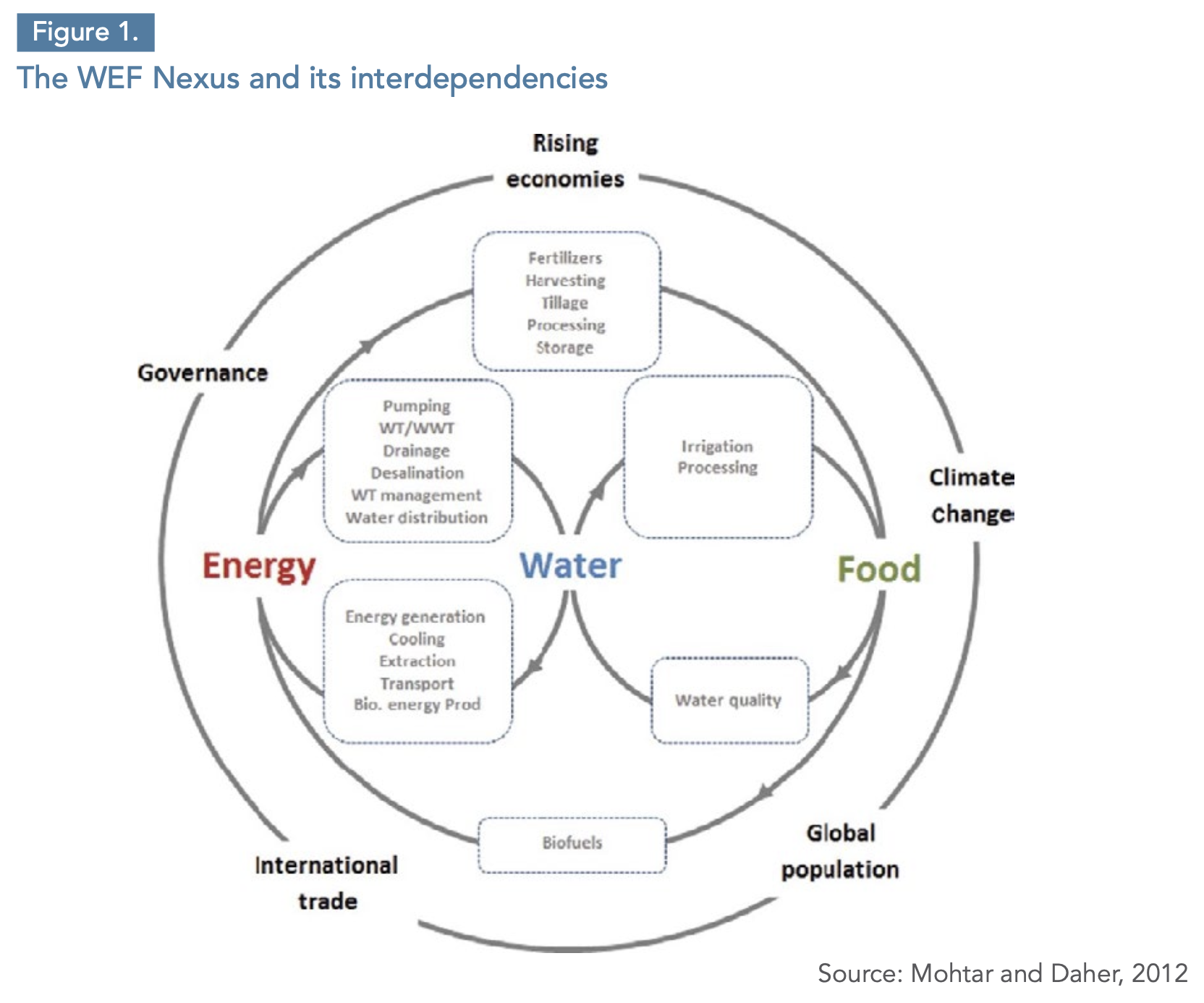
In a rural nexus system, it is important to understand the connections between governance authorities and their local and regional communications. This is achieved through enhanced farm sustainability, accounting for water storage, farm-waste management, energy production and use, crop production, and capacity building. These farm-scale activities also provide access to drinking water and sanitation, which are integral to the optimized frameworks: they enable resilience. Many nexus approaches have focused mostly on management of resources and enhancing productivity; yet, in rural settings, the water-energy-food nexus should focus also on the access to resources, the capacity to utilize resources as well as dynamics of social power relations and the strength of institutions (Biggs et al, 2015).
Meeting the demands of water, food, and energy with diminishing availability of arable land and water for irrigation in agriculture is a major scientific challenge. And even though there are multiple models and tools available, a unified framework to integrate them is still lacking, especially in the agriculture sector (Nie et al, 2019).
Water management the water demanded by all sectors, including the energy and the food sectors, which depend on water.
In sub-Saharan Africa, a business model of water and energy-use efficiency should be focused on accommodating the needs of poor smallholder farmers.
Case study: Water-Energy-Food Security in Morocco
Morocco recently announced a plan to better manage its water, energy, and food systems. The agricultural sector produces around 14% of the country’s GDP, but employs 40% of the population.
In the Green Morocco Plan for 2010–2020 (Agricultural Development Agency, 2008), the country laid out plans to double GDP from agriculture and add 15 million jobs (Al monitor, 2014). The crops in focus are olives, citrus, fruits, and vegetables. Another goal of the plan was to increase cereal yields, and use agricultural land for production of higher value crops.
The country relies heavily on imported energy sources. Projects to expand renewable energy sources are underway as part of the Morocco Energy Strategy 2030. Morocco is one of the first African countries to embrace renewable energy and align economic growth with sustainable development (Ben Meir et al, 2022).
Morocco also has an ambitious plan to expand industrial output, with an aim to double mining and triple chemical capacities. This requires intensive amounts of land, water, and resources.
All these plans require a multisectoral approach that promotes coherence and cooperation between policies and stakeholders.
In a study published by Daher and Mohtar (2021), the authors used a decision-making support system, the Nexus Tool 2.0, to quantify the resource requirements and impacts on the water, energy, and land domains, using different scenarios for achieving the national goals. Figure 2 shows the framework used to model these scenarios.
This simulation generated the possible increase in the required water, energy, and land if the country were to achieve 25%, 50%, 75%, and 100% of its national goals for agriculture, energy production (solar, wind and hydropower), and water production (through desalination and water treatment).

The comparison between different scenarios clearly showed the competition that exists between achieving national strategies for water, energy, and land. The plan to reallocate 20% of the land currently used for the production of cereals is a clear trade-off strategy where the country accepts less self-sufficiency in cereal production in order to reduce land and water stresses and allocate those resources for more energy self-sufficiency. Also, the scenario analysis showed how a short- term high investment in renewable energy production will release Moroccan budget resources in the long term, since it releases the country from the current budget allocated to energy imports and subsidies. Another clear tradeoff that this study showed is the increased energy requirements for desalination and wastewater treatment, versus decreased stress on Morocco’s already scarce water supply.
This is a clear example of the impact of the use of nexus tools for creating stronger regulatory frameworks and national strategies for water management, reducing groundwater overexploitation, while still strategically growing the rural areas to increase productivity. Even when the water and energy systems are well developed in Morocco, there is a need to develop more integrated water- energy-food nexus frameworks (El Youssfi et al, 2020).
Governments in Africa will obviously be compelled to invest more in infrastructure, water distribution and food, waste management, and energy independence. This must be done while also investing in climate adaptation and achieving the SDGs. Ultimately, all stakeholders have decisions to make now, while problems are still manageable.
KEY MESSAGES
- Water management is fundamentally connected to rural economic development, and as such must consider the new economic realities, including climate change and geopolitical circumstances. Improvements in water access and infrastructure intrinsically have a powerful effect on the prosperity and transformation of rural communities.
- Improve productivity and income through more efficient resource use.
- Water is a catalyst for increased resilience, improved livelihoods, and reduced socio-economic challenges.
- Reduce water, energy, food interdependencies through improved multisectoral policies, technologies, and adapted management that increases system resilience and reduces system interdependencies.
- One Water, One Health: better environmental control for disease prevention. Water is a common conduit between wild and domestic animals, and human exposure to animal diseases; it is important to raise the profile of water, sanitation, and wastewater management in the context of One Water, One Health, especially in Africa. The One Water, One Health concept is highly relevant, as more than half of human infectious diseases are zoonotic; more than three-quarters of emerging illnesses have a zoonotic link.
- Assessing the tradeoffs between water, nutrition, and agriculture, the productivity nexus, will enhance opportunities for research and development interventions.
- Recognize the importance of small-scale irrigation and provide opportunities for future investment.
- Develop a foreign investment framework that maintains a balance between market interests and developmental, environmental, and social needs.
- Engage and empower the targeted beneficiary rural communities to ensure that they are the drivers of the expected socio-economic development through water development and management.
- Water governance is key to enhancing cooperation among communities and implementing the SDG-6.
REFERENCES
2030 Water Resource Group. (2016). Partnerships for Transformation. Available from www.2030WRG.org
Agricultural Development Agency (2008) Green Morocco Plan. Retrieved through https://www.ada.gov.ma/en/foundations
Ben Meir, Yousef Kerstin Opfer, Ellen Hernandez, 2022. Decentralized renewable energies and the water-energy-food nexus in rural Morocco. Environmental Challenges. Volume 6, 2022, 100432, ISSN 2667-0100, https://doi.org/10.1016/j.envc.2021.100432
Biggs, E., Eleanor Bruce, Bryan Boruff, John M.A. Duncan, Julia Horsley, Natasha Pauli, Kellie McNeill, Andreas Neef, Floris Van Ogtrop, Jayne Curnow, Billy Haworth, Stephanie Duce, Yukihiro Imanari,, 2015. Sustainable development and the water–energy–food nexus: A perspective on livelihoods, Environmental Science & Policy, Volume 54, 2015, Pages 389-397, ISSN 1462-9011, https://doi.org/10.1016/j.envsci.2015.08.002.
Blake, J., A.T. Assi, R.H. Mohtar, E.F. Braudeau, C.L.S. Morgan. (2019). Quantification of available water capacity comparing standard methods and a pedostructure method on a weakly structured soil. Transactions of the ASABE, Vol. 62: 289-301.
Braudeau, E., A.T. Assi, and R.H. Mohtar. (2016). Hydrostructural Pedology. ISTE Ltd and John Wiley and Sons Inc. London, UK - Hoboken, NJ, USA..
Coulibaly, N., Coulibaly, T., Mpakama, Z., and Savané, I. (2018). The impact of climate change on water resource availability in a trans-boundary basin in West Africa: The case of Sassandra. Hydrology, 5(1), 12.
Daher, Bassel & Mohtar, Rabi, 2021. Water-Energy-Food Sustainable Development Goals in Morocco. 10.1007/978-3-319-70061-8_133-1. https://www.researchgate.net/publication/356213008_Water-Energy-Food_Sustainable_Development_Goals_in_Morocco/citation/download
Danert, K., S. Furey, M. Mechta, and S. Gupta. (2016). Effective Joint Sector Reviews for Water, Sanitation and Hygiene (WASH): A Study and Guidance—2016. World Bank Group: Water, Washington DC USA. Available from http://www. rural-watersupply. net/en/resources/details/757.
El Youssfi, Lahcen, Wesley Doorsamy, Adil Aghzar, Sidi Imad Cherkaoui, Ihssan Elouadi, Alex Godoy Faundez, and Diego Rivera Salazar, 2020. Review of water energy food nexus in Africa: Morocco and South Africa as case studies. E3S Web of Conferences 183, 02002 (2020) https://doi.org/10.1051/e3sconf/202018302002
FAO, 2016. AQUASTAT website. Food and Agriculture Organization of the United Nations Accessed June, 2024.
FAO, 2020. The State of Food and Agriculture 2020: Overcoming Water Challenges in Agriculture. Rome, FAO. www.fao.org/3/cb1447en/cb1447en.pdf
Hodder, G and Brenda Migwalla, 2023. Africa's agricultural revolution: From self-sufficiency to global food powerhouse. White and Case, July 12, 2023. Accessed online at https://www.whitecase.com/insight-our-thinking/africa-focus-summer-2023-africas-agricultural-revolution
IPCC, 2023: Climate Change 2023: Synthesis Report. Contribution of Working Groups I, II and III to the Sixth Assessment Report of the Intergovernmental Panel on Climate Change [Core Writing Team, H. Lee and J. Romero (eds.)]. IPCC, Geneva, Switzerland, pp. 35-115, doi: 10.59327/IPCC/AR6-9789291691647.
Kusangaya, S., M.L. Warburton, E.A. Van Garderen, and G.P. Jewitt. (2014). Impacts of climate change on water resources in southern Africa: A review. Physics and Chemistry of the Earth, Parts A/B/C, Vol. 67, 47-54.
Mohtar, R.H., Daher, B. (2012). Water, Energy, and Food: The Ultimate Nexus. In Encyclopedia of Agricultural, Food, and Biological Engineering Second Edition, Dennis R. Heldman, Carmen I. Moraru (Eds.) (pp. 1-15) Abingdon, UK: Taylor & Francis. DOI:10.1081/E-EAFE2-120048376.
Mohtar, R.H. and A. Assi, 2018. The Role of New and Green Water Resources in Localizing Water and Food Security Under Arid and Semiarid Conditions. In: The Oxford Handbook of Food, Water and Society. Allan, T., B. Bromwich, T. Colman, and M. Keulertz (Eds.). Oxford University Press. DOI: 10.1093/oxfordhb/9780190669799.013.45
Nie, Yang, Styliani Avraamidou, Xin Xiao, Efstratios N. Pistikopoulos, Jie Li, Yujiao Zeng, Fei Song, Jie Yu, Min Zhu, 2019. A Food-Energy-Water Nexus approach for land use optimization. Science of The Total Environment, Volume 659, 2019, Pages 7-19, ISSN 0048-9697, https://doi.org/10.1016/j.scitotenv.2018.12.242
OECD/FAO (2021), OECD-FAO Agricultural Outlook 2021-2030, OECD Publishing, Paris, https://doi.org/10.1787/19428846-en
Our World in Data – The World Bank (2024). “Data Page: Agricultural value added per worker”. Data adapted from World Bank based on data from multiple sources. Retrieved from https://ourworldindata.org/grapher/agriculture-value-added-per-worker-wdi [online resource]
UN Water, 2003. United Nations. Economic Commission for Africa; United Nations. Economic Commission for Africa; African Union Commission; African Development Bank (2003). Africa water vision for 2025 : equitable and sustainable use of water for socioeconomic development. Addis Ababa. https://hdl.handle.net/10855/5488”
UN, 2024. The United Nations World Water Development Report 2024: water for prosperity and peace. UNESCO World Water Assessment Programme. Chapter 2. ISBN :978-92-3-100657-9. Accessed online at https://unesdoc.unesco.org/ark:/48223/pf0000388948/PDF/388948eng.pdf.multi.page=44

